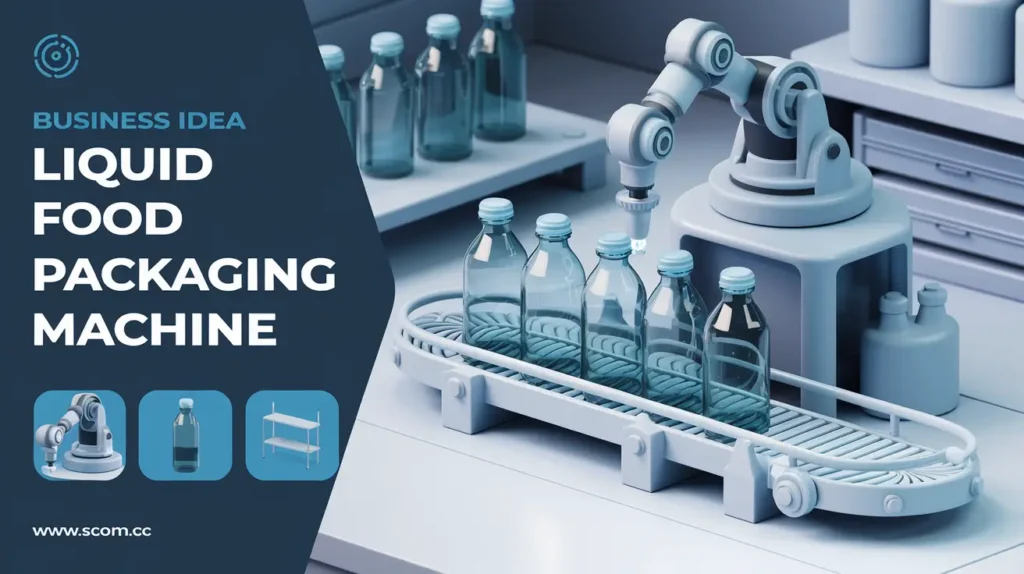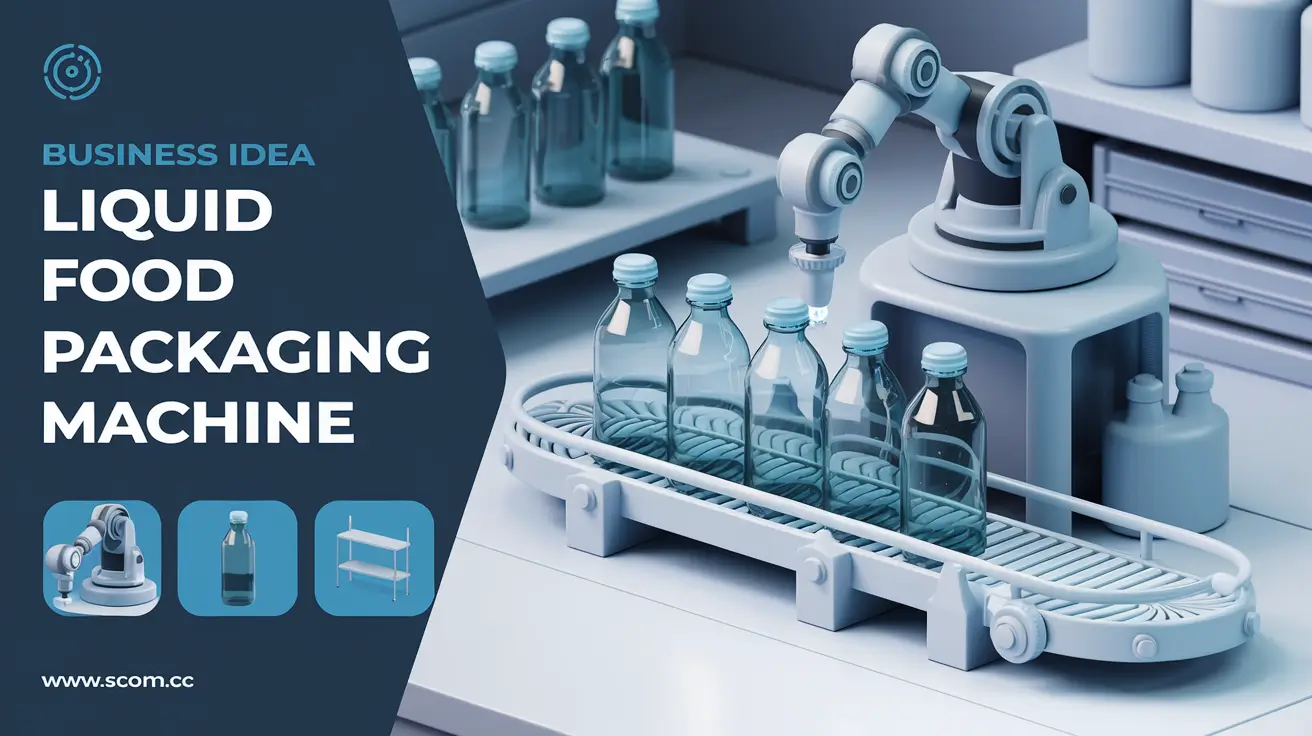Business Idea Liquid Food Packaging Machine

- Business Idea Liquid Food Packaging Machine: A Gateway to Convenient Packaging Solutions
- What is a Liquid Food Packaging Machine?
- Market Potential for Liquid Food Packaging Machines
- Initial Costs and Equipment
- The Packaging Process
- Market Opportunities and Applications
- Marketing and Sales Strategies
- Quality Control and Compliance
- Scaling Your Business
- Financial Management and Profitability
-
FAQ
- What is a liquid food packaging machine?
- How much does it cost to start a liquid food packaging business?
- What types of liquids can be packaged with this machine?
- How do I set up and operate a liquid food packaging machine?
- Where can I sell packaged liquid products?
- How do I ensure the quality of the packaged products?
- Can I customize the packaging with labels or designs?
Business Idea Liquid Food Packaging Machine: A Gateway to Convenient Packaging Solutions
In today’s market, convenience and quality are key drivers in consumer purchasing decisions, especially in the food and beverage sector. For producers of liquids such as jams, sauces, and smoothies, the right packaging can make a significant difference in product appeal and operational efficiency. Investing in a liquid food packaging machine offers a practical solution for achieving high-quality packaging while meeting the demands of modern consumers. This business idea explores the benefits, market potential, and practical considerations of using a liquid food packaging machine.
What is a Liquid Food Packaging Machine?
A liquid food packaging machine is designed to package liquid products, such as jams, sauces, smoothies, and other beverages, into various types of containers. These machines ensure that liquids are sealed securely and presented attractively for consumers.
Key Features and Functions
- Filling Mechanism: Accurately dispenses the liquid product into containers.
- Sealing System: Seals the containers to prevent leakage and ensure product freshness.
- Container Handling: Manages the movement of containers through the packaging process, including loading, filling, and sealing.
- Adjustable Settings: Allows for customization of filling volumes and packaging types to accommodate different products and container sizes.
Market Potential for Liquid Food Packaging Machines
The demand for liquid food products is growing, driven by consumer preferences for convenient and ready-to-use items. A liquid food packaging machine can cater to this expanding market by providing efficient and high-quality packaging solutions.
Target Markets
- Organic and Healthy Food Producers: Companies focusing on organic, natural, and health-conscious products can benefit from packaging machines that enhance product appeal and convenience.
- Small to Medium-Sized Food Businesses: Smaller producers looking to scale their operations or improve packaging efficiency will find value in affordable and reliable packaging solutions.
- Beverage Manufacturers: Companies producing juices, smoothies, and other liquid beverages require efficient packaging to meet market demands.
Market Trends
- Growing Demand for Convenience: Consumers increasingly seek ready-to-use and conveniently packaged food products.
- Health and Wellness Focus: There is a rising trend toward healthier, organic, and natural food options, driving demand for innovative packaging solutions.
- Eco-Friendly Packaging: There is a growing emphasis on sustainable and environmentally friendly packaging materials.
Initial Costs and Equipment
Starting a liquid food packaging business involves several key investments, primarily focusing on acquiring the machinery and associated materials.
Initial Cost Breakdown
- Liquid Food Packaging Machine: Prices for basic models start at approximately $200, with costs varying based on machine size, features, and production capacity.
- Containers and Labels: Invest in various types of containers (e.g., bottles, pouches) and labels to suit your product range and branding needs.
- Maintenance and Supplies: Budget for regular maintenance, cleaning supplies, and any additional equipment required for smooth operation.
Optional Investments
- Advanced Machinery: Consider investing in higher-end models with additional features such as automated filling, labeling, and quality control systems.
- Packaging and Design: Invest in custom packaging designs and materials to enhance product appeal and differentiation in the market.
The Packaging Process
Understanding the liquid food packaging process is essential for maximizing efficiency and ensuring high-quality results. Here’s a step-by-step guide to using a liquid food packaging machine.
Step 1: Preparing the Liquid Product
- Product Formulation: Prepare the liquid product according to your recipe or formulation, ensuring consistency and quality.
- Pre-Processing: If necessary, pre-process the product to remove impurities or adjust viscosity.
Step 2: Setting Up the Machine
- Loading Containers: Place empty containers into the machine’s feeding system.
- Adjusting Settings: Configure the machine’s settings for filling volume, sealing parameters, and container type.
Step 3: Filling and Sealing
- Filling: The machine accurately dispenses the liquid product into the containers.
- Sealing: Containers are sealed to prevent leakage and ensure product freshness.
Step 4: Quality Control
- Inspection: Regularly inspect the filled and sealed containers for consistency, quality, and any defects.
- Adjustments: Make necessary adjustments to the machine settings or processes to address any issues.
Market Opportunities and Applications
Liquid food packaging machines offer a wide range of applications across various sectors. Identifying and targeting key market opportunities can help maximize the potential of your packaging business.
Common Applications
- Jams and Jellies: Package fruit preserves and spreads in convenient, consumer-friendly containers.
- Sauces and Condiments: Offer a variety of sauces, dressings, and condiments in attractively packaged bottles or pouches.
- Smoothies and Beverages: Package ready-to-drink smoothies, juices, and other liquid beverages for convenience and freshness.
Potential Niches
- Custom Packaging: Offer custom-sized and custom-designed containers for specific client needs or branding purposes.
- Eco-Friendly Solutions: Provide packaging options that use sustainable materials or offer recyclable/biodegradable alternatives.
Marketing and Sales Strategies
Effective marketing and sales strategies are essential for building a successful liquid food packaging business. Here’s how to promote your products and attract customers.
Online Presence
- Website and E-Commerce: Create a professional website showcasing your packaging solutions, pricing, and ordering options. Consider setting up an online store for direct sales.
- Social Media: Use social media platforms to share information about your products, industry news, and special offers. Engage with potential customers and industry influencers.
Offline Marketing
- Trade Shows and Events: Attend food industry trade shows and events to showcase your packaging solutions and network with potential clients and partners.
- Local Advertising: Advertise in local business directories, newspapers, or industry magazines to reach potential customers in your area.
Sales Channels
- Direct Sales: Build relationships with food producers, manufacturers, and retailers to secure direct sales agreements.
- Wholesale Distribution: Establish wholesale partnerships with distributors and suppliers to expand your reach and increase sales volume.
Quality Control and Compliance
Maintaining high quality and compliance with industry standards is crucial for building a reputable business and ensuring customer satisfaction.
Quality Assurance
- Product Consistency: Ensure that your packaging consistently meets quality standards in terms of fill levels, seal integrity, and overall appearance.
- Regular Testing: Conduct regular testing and inspections to identify and address any issues with the packaging process or final product.
Compliance and Regulations
- Food Safety Standards: Adhere to food safety standards and regulations to ensure that your packaging process meets industry requirements.
- Environmental Regulations: Comply with environmental regulations regarding the use of packaging materials and consider implementing eco-friendly practices where possible.
Scaling Your Business
As your liquid food packaging business grows, consider strategies for scaling operations and expanding your market reach.
Increasing Production Capacity
- Additional Machines: Invest in additional packaging machines or upgrade to higher-capacity models to handle larger orders and increase production efficiency.
- Expanding Facilities: Consider expanding your production facility to accommodate increased output and streamline operations.
Market Expansion
- New Markets: Explore opportunities to enter new markets or regions, targeting industries that require liquid food packaging solutions.
- Product Diversification: Offer additional packaging solutions or related products to complement your liquid food packaging services and appeal to a broader customer base.
Financial Management and Profitability
Effective financial management is essential for ensuring the long-term success and profitability of your liquid food packaging business.
Budgeting and Cost Management
- Expense Tracking: Monitor your expenses related to equipment, materials, and operations to stay within budget and optimize profitability.
- Pricing Strategy: Set competitive prices for your packaging services, considering factors such as production costs, market demand, and profit margins.
Monitoring Profitability
- Sales Analysis: Regularly review your sales data to identify trends, evaluate performance, and make informed business decisions.
- Profit Margins: Calculate and monitor your profit margins to ensure your business remains financially sustainable and adjust your strategies as needed.
By focusing on efficiency, quality, and effective marketing, you can build a successful liquid food packaging business that meets the needs of various industries and provides valuable solutions for packaging liquid products.
FAQ
What is a liquid food packaging machine?
A liquid food packaging machine is a device that packages liquid products, such as jams, sauces, and smoothies, into containers. It ensures that the liquids are filled and sealed securely for consumer use.
How much does it cost to start a liquid food packaging business?
The initial cost for a basic liquid food packaging machine starts at around $200. Additional costs include containers, labels, and maintenance supplies.
What types of liquids can be packaged with this machine?
The machine can package a variety of liquids, including jams, sauces, smoothies, juices, and other beverages.
How do I set up and operate a liquid food packaging machine?
Set up involves loading containers, adjusting machine settings for filling volumes and sealing, and preparing the liquid product. The machine then fills and seals the containers automatically.
Where can I sell packaged liquid products?
Packaged liquid products can be sold through grocery stores, specialty food shops, online retailers, and directly to consumers through e-commerce platforms.
How do I ensure the quality of the packaged products?
Regularly inspect the filled and sealed containers for consistency and quality. Conduct tests to ensure the product meets safety and quality standards.
Can I customize the packaging with labels or designs?
Yes, you can customize packaging with labels or designs to enhance product branding and appeal. Consider working with a design and printing service to create attractive packaging options.

If you enjoyed this article and found it valuable, we encourage you to explore our news and valuable information section, where you'll find more relevant and up-to-date content that may pique your interest. Additionally, if you are seeking advice or need guidance on a specific topic, we suggest visiting our services section. There, you will find a variety of options designed to assist and support you in addressing your needs. Feel free to check out both sections to get the information and assistance that best suits your requirements.

Leave a Reply